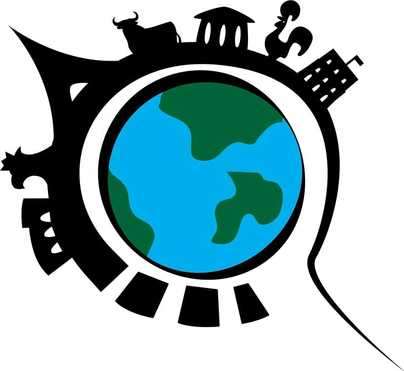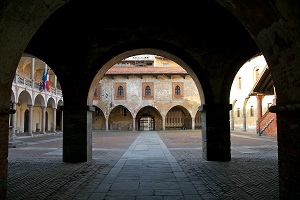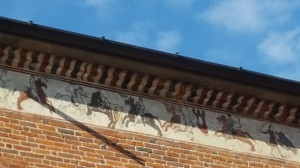Erasmus+ project : Minds on the Move !
Applying Geocaching to Education

This cache is a part of a pedagogic European Erasmus + project called « Geocaching - Minds on the Move ». Pupils and teachers from seven different countries (France, Greece, Italy, Lithuania, Poland, Portugal and Spain) have used Geocaching as an Educational Tool. We hope you’ll enjoy it.
----------------------------------------------



THE NOBLE FRANK, THE LADY AND HER LOVER
The story goes that, in the old times, on occasion of a Jubilee, a young man of royal origins was travelling to Rome from the land of the Franks with his beautiful wife. The journey was long and quite exhausting so they decided to stop for a few days in a place called Casaleggio (a village still existing nowadays, not far from here). They were hosted for a few days by a noble family in their manor. There the beautiful lady fell in love with a young nobleman, beginning a love affair.
While the husband was getting ready to leave and continue the journey to Rome, his wife was looking for an excuse to remain in those lands with her lover, so she pretended she was sick. Her husband, who was at the same time self-centered and naive, left for Rome by himself. But when he was on the way he kept thinking about his poor wife, ill and lonely, and he felt guilty; so he suddenly decided to go back to her. Unfortunately, once there he caught his wife in the arms of her young lover.
In order to run away from the husband’s rage the two lovers sought refuge in a castle not far from there. But the Frank nobleman found them: he was so mad that he set the castle to fire, and ordered his wife to be burnt and her lover to be hanged.
In the old times this sort of things were quite normal, so the pope pardoned the Frank provided he would have built a church in the name of the saints Gervasio and Protasio, in honour of the bishop of Milan, who was the owner of the lands. The church was soon erected on a small hill between the rivers Agogna and Terdoppio. And near the church a new town was established – its name was NOVARIA.
Of course this is just a story, reported by the historian Pietro Azario (1312-1366) as part of a propaganda campaign on behalf of the Visconti family and their friends. Anyhow, it contributes to give a romantic and dramatic twist to the story of the city.
From now on, when you cross the courtyard, give a glance to the two figures on the left end of the frieze – you will remember what you have just read.
Some other historians have given a different meaning to the same two figures: they say that they portray a soldier making love to his girl. The soldier is apparently leaving for war and the act was reckoned to bring good luck and to propitiate victory over the enemies.
But the legend sounds much more intriguing, doesn’t it?!
Do the Quiz to get a useful HINT to find the CACHE:
Be careful – the hint is important since the coordinates might mislead you.
PER TROVARE LA CACHE OCCORRE RISOLVERE IL QUIZ (AL TERMINE DEL QUALE TROVERETE UN PREZIOSO INDIZIO/SUGGERIMENTO):
https://learningapps.org/watch?v=p4ww8vova22
The cache is MAGNETIC
-----------------------------------------------
Il Broletto di Novara è un complesso architettonico medioevale costituito da quattro edifici storici sorti in epoche diverse, con stili artistici differenti ma comunque in armonia, disposti a quadrilatero attorno ad un cortile (o "Arengo") centrale. Vi si accede tramite un passaggio ad arco da Piazza della Repubblica (a sud) ed un secondo arco da Corso Italia (a nord). Attualmente vi si tengono mostre ed esposizioni temporanee e nel periodo estivo il cinema all'aperto. Il nome ‘Broletto deriva dal latino ‘Brolo’ che significa cortile. È stato il centro economico e sociale della città di Novara a partire dal Medioevo.
A NORD si trova l’edificio più vecchio, il Palazzo dell’Arengo che risale al XIII secolo ed era la sede del Consiglio di Giustizia, incaricato di giudicare le cause civili, mentre al piano superiore si trova un ampio salone che veniva usato per le assemblee pubbliche; sulla facciata vi sono i resti di un fregio pittorico risalente all'incirca al 1460 rappresentante stemmi e scene di episodi cavallereschi. A EST si trova il Palazzo Paratici che apparteneva alle corporazioni artigiane, e nel XVIII secolo è stato ampliato con un portico e una loggia. A SUD si trova il Palazzo della Podestà, il palazzo del capo magistrato della città (ovvero la posizione più importante nel Medioevo). A OVEST si trova il Palazzo dei Referendari, il palazzo degli ufficiali che lavoravano per il Podestà.
Il nobile tedesco, sua moglie e l'amante
La leggenda narra di un giovane tedesco di nobili origini diretto verso Roma in occasione del Giubileo, insieme alla sua bellissima moglie. Il viaggio era lungo ed estenuante, per cui la coppia decide di fermarsi per qualche giorno in un posto chiamato Casaleggio, ospitati da una famiglia nobile. La moglie si innamora del nobile che la ospita. Mentre il marito si sta preparando per continuare il pellegrinaggio, la consorte cerca una scusa per rimanere insieme al suo innamorato, dice quindi di essersi ammalata, per cui suo marito prosegue il viaggio senza di lei, ma preso dal rimorso per aver abbandonato la sua povera compagna, malata e sola, torna subito indietro: sfortunatamente, una volta tornato, trova i due amanti insieme, i quali decidono di scappare in un castello vicino. Il marito però, riesci a trovarli dopo poco e diede fuoco al castello, poi ordinò che sua moglie venne bruciata e che l’amante venne impiccato. Nel passato questo tipo di cose era abbastanza normale, per cui il Papa decide di perdonare l’uomo a patto che egli costruisse una chiesa per celebrare i Santi Gervasio e Protasio: la chiesa fu eretta su una collina tra le rive dell’Agogna e del Terdoppio e vicino alla chiesa nacque una citta: Novaria.
Se guardate al fregio situato nella parte alta del Palazzo dell'Arengo potete scoprire alcune figure collegate alla storia che avete appena letto...
Nel passato, la piazza del Broletto era la sede di un mercato: le bancarelle erano posizionate tutte intorno, i cronisti facevano i loro annunci su una pietra alta, sotto gli archi, il Consiglio della Giustizia faceva il suo lavoro e i detenuti venivano condannati ed esposti alle umiliazioni del pubblico. Le tasse venivano pagate sotto gli archi situati a nord e ogni quartiere del villaggio aveva il suo tavolo riconoscibile grazie ai dei simboli (solitamente di animali).
Nel cortile si trova un pozzo: nel 1356 le truppe dei Marchesi del Monferrato occuparono la città, per cui gli abitanti della città e dei villaggi vicini erano preoccupati che venissero imposte nuove tasse, quindi attaccarono il Broletto, sequestrarono i documenti nei banchi dei notai e li buttarono dentro al pozzo.